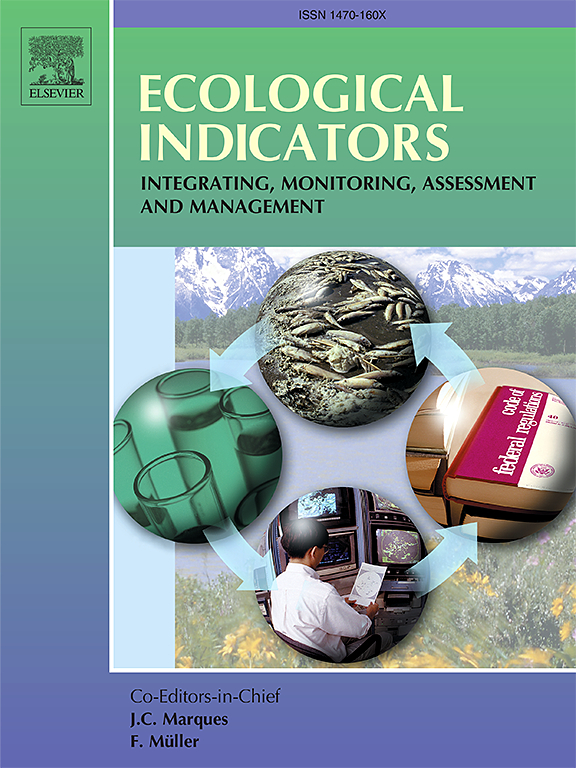Hydrological shifts from vegetation restoration in semi-arid regions: insights from the typical watersheds of the Yellow River
IF 7
2区 环境科学与生态学
Q1 ENVIRONMENTAL SCIENCES
引用次数: 0
Abstract
Vegetation restoration in semi-arid regions presents complex tradeoffs between ecological benefits and hydrological impacts. This study focused on three representative watersheds Loess Plateau the middle of the Yellow River in China—Huangfu (HFC), Yanhe (YH), and Juhe (JH)—each undergoing distinct land use scenarios: grassland restoration, conversion of cropland to artificial forest, and predominance of forest cover, respectively. We utilized the Soil and Water Assessment Tools (SWAT) to evaluate the impact of “Grain for Green” initiative on various hydrological elements—streamflow, evapotranspiration, soil moisture, and water yield. In these watersheds, vegetation restoration has resulted in a 10.86–43.47 mm increase in evapotranspiration, a 1.38–24.89 mm decrease in soil moisture, a 5.13 mm to 26.89 mm reduction in annual runoff depth, and a 5.94–18.58 mm decrease in water yield. Specifically, Natural grassland restoration in the HFC watershed increased evaporation by 15.06 mm, reduced soil moisture by 1.38 mm, reduced annual average runoff depth by 5.13 mm, and decreased water yield 11 mm. Large-scale conversion of cropland to artificial forest in the YH watershed significantly resulted in an increase in evaporation by 43.47 mm, accompanied by a reduction in soil moisture by 24.89 mm, meanwhile, vegetation restoration enhanced the catchment capacity of the watershed, reducing the annual runoff depth by 26.89 mm and the water yield by 18.58 mm. Nature forests in the JH watershed maintained stable precipitation-streamflow coupling relationship despite climate variability, and with the increase of natural forest land, the streamflow in the watershed decreased by 6.86 mm. This study provides robust quantitative insights into how various vegetation restoration scenarios alter key hydrological components, thereby elucidating the balance between ecosystem recovery and water resource dynamics in semi-arid watersheds.
半干旱区植被恢复带来的水文变化:来自黄河典型流域的启示
半干旱区植被恢复存在生态效益与水文影响之间的复杂权衡。本研究以中国黄河中游黄土高原3个代表性流域为研究对象,分别经历了不同的土地利用情景:草地恢复、退耕还林和森林覆盖优势。我们利用水土评估工具(SWAT)来评估“退耕还林”计划对各种水文要素(流量、蒸散、土壤湿度和水量)的影响。植被恢复后,流域蒸散量增加10.86 ~ 43.47 mm,土壤水分减少1.38 ~ 24.89 mm,年径流深度减少5.13 ~ 26.89 mm,产水量减少5.94 ~ 18.58 mm。其中,HFC流域自然草地恢复使蒸发量增加了15.06 mm,土壤水分减少了1.38 mm,年平均径流深度减少了5.13 mm,产水量减少了11 mm。YH流域大规模退耕还林显著增加了流域蒸发量43.47 mm,土壤水分减少24.89 mm,同时植被恢复增强了流域的汇水能力,年径流深度减少26.89 mm,产水量减少18.58 mm。在气候变率的影响下,JH流域天然林保持了稳定的降水-流量耦合关系,随着天然林面积的增加,流域流量减少了6.86 mm。该研究为不同植被恢复情景如何改变关键水文成分提供了强有力的定量见解,从而阐明了半干旱流域生态系统恢复与水资源动态之间的平衡。
本文章由计算机程序翻译,如有差异,请以英文原文为准。
求助全文
约1分钟内获得全文
求助全文
来源期刊

Ecological Indicators
环境科学-环境科学
CiteScore
11.80
自引率
8.70%
发文量
1163
审稿时长
78 days
期刊介绍:
The ultimate aim of Ecological Indicators is to integrate the monitoring and assessment of ecological and environmental indicators with management practices. The journal provides a forum for the discussion of the applied scientific development and review of traditional indicator approaches as well as for theoretical, modelling and quantitative applications such as index development. Research into the following areas will be published.
• All aspects of ecological and environmental indicators and indices.
• New indicators, and new approaches and methods for indicator development, testing and use.
• Development and modelling of indices, e.g. application of indicator suites across multiple scales and resources.
• Analysis and research of resource, system- and scale-specific indicators.
• Methods for integration of social and other valuation metrics for the production of scientifically rigorous and politically-relevant assessments using indicator-based monitoring and assessment programs.
• How research indicators can be transformed into direct application for management purposes.
• Broader assessment objectives and methods, e.g. biodiversity, biological integrity, and sustainability, through the use of indicators.
• Resource-specific indicators such as landscape, agroecosystems, forests, wetlands, etc.
 求助内容:
求助内容: 应助结果提醒方式:
应助结果提醒方式:


